Why Water Treatment?
You may wonder why you must always use water treatment in your outdoor boiler. The photos below illustrate how fast corrosion can occur in a boiler system when water treatment is not used. We began our experiment on October 1, 2008 and was continued through January 27, 2010. The grade of steel used is A-36. The water used is right from our tap. Both pieces were placed in identical open containers to simulate an open boiler system. The water treatment used is the Water Treatment 101 and is tested to a level of 1100 ppm at all times. Please note, this was kept at room temperature. Heating the water (as it is in a boiler system) causes corrosion at a much faster rate.

October 3, 2008
The piece on the left is submerged in the ordinary water. The piece on the right is submerged in the water with treatment. After two days rust is already starting to form, but can still be easily removed.
The piece on the left is submerged in the ordinary water. The piece on the right is submerged in the water with treatment. After two days rust is already starting to form, but can still be easily removed.
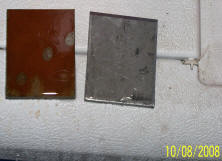
October 8, 2008
The piece on the left is again the one without treatment, the right piece is with treatment. There is even more rust visible, and it's already more difficult to remove even though only one week has passed.
The piece on the left is again the one without treatment, the right piece is with treatment. There is even more rust visible, and it's already more difficult to remove even though only one week has passed.
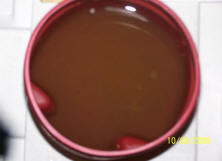
October 8, 2008
This photo shows the discoloration of the water in the container that does not contain any water treatment
This photo shows the discoloration of the water in the container that does not contain any water treatment
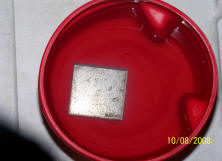
October 8, 2008
This photo show the clarity of the water in the container that does contain water treatment.
This photo show the clarity of the water in the container that does contain water treatment.
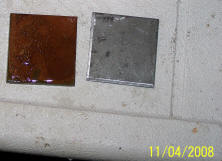
November 4, 2008
After one month, the untreated left piece is extremely corroded and is starting to show evidence of pitting. The right, treated piece still looks like brand new.
After one month, the untreated left piece is extremely corroded and is starting to show evidence of pitting. The right, treated piece still looks like brand new.
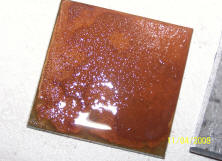
November 4, 2008
This close up shows the amount of corrosion and damage that has occurred in just one month
This close up shows the amount of corrosion and damage that has occurred in just one month
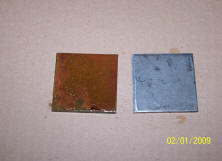
February 1, 2009
Four months later, the untreated piece is on the left, the treated piece is on the right.
Four months later, the untreated piece is on the left, the treated piece is on the right.
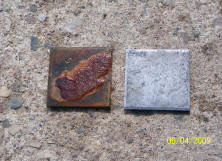
June 4, 2009
Eight months have gone by now, and the amount of scale and corrosion on the left, untreated piece in unbelievable! This type of deposit eats away at the steel and thins it out significantly...a location like this is prime for leaks. Meanwhile, the right, treated piece is still good as new!
Eight months have gone by now, and the amount of scale and corrosion on the left, untreated piece in unbelievable! This type of deposit eats away at the steel and thins it out significantly...a location like this is prime for leaks. Meanwhile, the right, treated piece is still good as new!
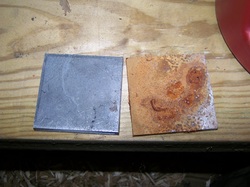
January 27, 2010
15 months have passed. The amount of scale on the piece that is untreated is incredible (right side), while the treated piece is still looking like new. It should also be noted that this is kept at room temperature, not the 160°-180° of boiler water.
15 months have passed. The amount of scale on the piece that is untreated is incredible (right side), while the treated piece is still looking like new. It should also be noted that this is kept at room temperature, not the 160°-180° of boiler water.
More of why water treatment:
Water treatment goes beyond keeping steel looking new. Water contains all sorts of additional things that we don't see when it comes out of our taps. Water can contain: nitrates, nitrites, calcium, iron, and a lot of other things that we never see. Many of the "invisible" additives of water become visible in your home- maybe you can see rust in your bathtub from iron deposits, or maybe your dishwasher or hot water heater becomes clogged with calcium from hard water lime scale.
All of things that you can see happen in your home from your water also happen to your boiler from your water...you just can't see them as easily until a problem develops. When you heat the water in your stove it can cause lime scale buildup in the bottom of the boiler. This causes a condition called under deposit corrosion, where the steel begins to oxidize from under the lime deposit. This can lead to a costly repair. The best preventative is of course Water Treatment 101, but it is also very important to only fill your stove with soft water to avoid leaving the hard water deposits. If you don't have a water softener, you can purchase a softening kit. If you use a water softener, please check to make sure it can handle the capacity that it takes to fill your stove.
Not flushing your system every two to three years can cause a problem as well. Bacteria can enter an open system at any time, and bacteria can cause corrosion. Additionally, sludge can build up in your system, and will harden over time, causing corrosion.
A little bit of maintenance can help prevent a lot of headache later on. Always using Treatment 101, testing to make sure it's at a proper level, and cleaning your furnace by draining and flushing it every two to three years with Prep 102 can extend the life of your stove and give you years of enjoyable wood heat!
All of things that you can see happen in your home from your water also happen to your boiler from your water...you just can't see them as easily until a problem develops. When you heat the water in your stove it can cause lime scale buildup in the bottom of the boiler. This causes a condition called under deposit corrosion, where the steel begins to oxidize from under the lime deposit. This can lead to a costly repair. The best preventative is of course Water Treatment 101, but it is also very important to only fill your stove with soft water to avoid leaving the hard water deposits. If you don't have a water softener, you can purchase a softening kit. If you use a water softener, please check to make sure it can handle the capacity that it takes to fill your stove.
Not flushing your system every two to three years can cause a problem as well. Bacteria can enter an open system at any time, and bacteria can cause corrosion. Additionally, sludge can build up in your system, and will harden over time, causing corrosion.
A little bit of maintenance can help prevent a lot of headache later on. Always using Treatment 101, testing to make sure it's at a proper level, and cleaning your furnace by draining and flushing it every two to three years with Prep 102 can extend the life of your stove and give you years of enjoyable wood heat!
The slide show below illustrates some of the problems that we've seen with not treating your water: